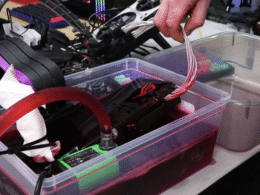### Summary
– Seagate announces significant investments aimed at increasing hard drive capacities, targeting advancements in laser technology.
– The company aims to achieve a single disk capacity of 10TB by 2032, paving the way for ultra-large hard drives exceeding 100TB.
– Future hard drives are positioned primarily for data centers and AI applications, demanding massive storage solutions.
—
In a landmark development for the storage technology sector, Seagate is making headlines with its ambitious plans to revolutionize hard drive capacities. With the release of 256TB SSDs this year, the traditional HDD mechanical hard drives are facing a new reality where their capacity advantage is significantly diminished. Currently, the largest HDD available on the market maxes out at just 32TB, highlighting an urgent need for advancement in this sector.
### Seagate’s Strategic Investment
To meet these challenges, Seagate has announced a substantial investment of £115 million (approximately RMB 1.12 billion) over the next five years into its Ireland-based subsidiary, Mozaic. This investment is primarily focused on developing cutting-edge laser technology that promises to drive advancements in head supplier processes.
Seagate aims for a breakthrough achievement of 6TB capacity per disk while setting its sights on a future goal of reaching 10TB per disk—a technical milestone defined earlier this year. Such advancements are critical for the evolution of hard disk drives (HDDs) as they transition from conventional capacities to those that can satisfy the burgeoning demands of modern data requirements.
### The Future of HDDs: 100TB Hard Drives
If Seagate successfully realizes its design of a 10TB single disk complemented by at least ten disks in a hard drive configuration, the potential for these systems is staggering. A multi-disk setup could yield a storage capacity exceeding 100TB, with Seagate projecting the delivery of these ultra-large hard drives by 2032.
The timeline for achieving such technological marvels has shifted over the years. Initially, industry roadmaps suggested that storage innovations of this magnitude would be hit by around 2030. However, the evolving landscape underlines the necessity to adapt to new challenges and opportunities.
### Addressing Data Center Needs
It is essential to note that these forthcoming hard disks are not intended for the consumer market. Instead, they are designed with enterprise solutions in mind, particularly focusing on data centers that are rapidly evolving to support today’s AI applications. The current trends indicate that advanced processing tasks require not just superior performance metrics with GPUs and HBM memory, but also a staggering level of storage that far exceeds the capabilities of existing HDDs, which typically hover around 20-30TB.
This strategic focus by Seagate positions it at the forefront of a crucial market transformation. As data generation continues to skyrocket, enterprises are under increasing pressure to adopt storage solutions that can handle exabyte-level data capacities, which will be imperative for emerging technologies and expansive datasets.
### Conclusion
As we look toward the future, Seagate’s innovative pursuits signal a monumental shift in data storage technology. With a clear roadmap to achieve unprecedented capacities, the arrival of 100TB HDDs could redefine standards in data storage solutions, particularly for sectors reliant on large-scale data management.
It’s an exciting time for the tech industry, as these advancements not only promise to enhance performance but also ensure that enterprises are well-equipped to handle the complexities of future data landscapes.









